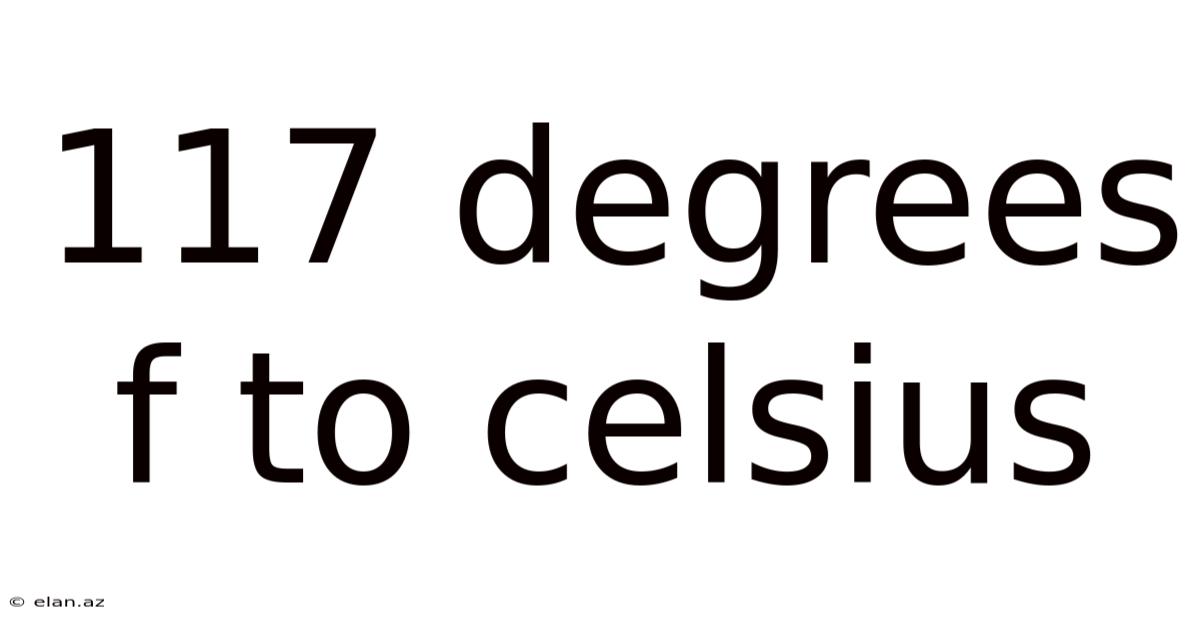117 Degrees F To Celsius
elan
Sep 21, 2025 · 4 min read

Table of Contents
Converting 117 Degrees Fahrenheit to Celsius: A Comprehensive Guide
Are you wondering how to convert 117 degrees Fahrenheit (°F) to Celsius (°C)? This seemingly simple conversion is a fundamental concept in science and everyday life, impacting everything from cooking to weather forecasting. This article will provide a clear, step-by-step explanation of the conversion process, delve into the underlying science, and answer frequently asked questions. We'll also explore the significance of this specific temperature and its implications across different contexts.
Understanding Fahrenheit and Celsius Scales
Before diving into the conversion, let's briefly understand the two temperature scales involved. Both Fahrenheit (°F) and Celsius (°C) are used to measure temperature, but they use different reference points.
-
Fahrenheit: This scale was invented by Daniel Gabriel Fahrenheit in the early 18th century. It sets the freezing point of water at 32°F and the boiling point at 212°F, with 180 degrees separating the two.
-
Celsius: Also known as the Centigrade scale, it was developed by Anders Celsius. It defines the freezing point of water at 0°C and the boiling point at 100°C, with 100 degrees separating them.
The difference in reference points and the number of degrees between freezing and boiling water are the key reasons why a conversion formula is necessary when switching between these scales.
The Conversion Formula: From Fahrenheit to Celsius
The formula for converting Fahrenheit to Celsius is:
°C = (°F - 32) × 5/9
This formula takes the Fahrenheit temperature, subtracts 32 (to account for the difference in freezing points), and then multiplies the result by 5/9 (to adjust for the different degree intervals).
Step-by-Step Conversion of 117°F to °C
Let's apply this formula to convert 117°F to Celsius:
-
Subtract 32: 117°F - 32°F = 85°F
-
Multiply by 5/9: 85°F × 5/9 = 47.22°C (approximately)
Therefore, 117°F is approximately equal to 47.22°C.
The Significance of 47.22°C (117°F)
A temperature of 47.22°C (117°F) is considered relatively warm. Its significance varies depending on the context:
-
Weather: This temperature is considered quite warm, especially for temperate climates. It's often associated with hot summer days. Many people would find this temperature uncomfortable without air conditioning or other forms of cooling.
-
Cooking: This temperature is suitable for cooking many dishes. It's within the range often used for baking and simmering. Specific applications would depend on the recipe and desired outcome.
-
Industrial Processes: In various industrial settings, this temperature might be used for certain processes requiring moderate heat. This could include chemical reactions, material processing, or other temperature-sensitive operations. Specific applications would depend on the material and processes involved.
-
Human Body Temperature: While not a critical temperature for human health, it is significantly higher than the average human body temperature of 37°C (98.6°F). Prolonged exposure to this temperature could lead to heat stress and potentially more serious health issues.
Further Exploration: The Science Behind the Conversion
The conversion formula is derived from the relationship between the Fahrenheit and Celsius scales. The key is understanding the different reference points and the ratio of the degree intervals. As we've seen, the freezing and boiling points of water are fundamental to both scales. The formula effectively adjusts for these differences to ensure accurate conversion. The ratio 5/9 reflects the relationship between the size of a degree Celsius and a degree Fahrenheit.
Frequently Asked Questions (FAQ)
-
Why is the conversion formula not a simple multiplication or division? Because the scales have different zero points, a simple multiplication wouldn't accurately account for the offset. The subtraction of 32 corrects for the difference in the freezing point of water.
-
Can I use online converters for Fahrenheit to Celsius conversions? Yes, many reliable online converters are available. These can be a quick way to perform the conversion, but understanding the underlying formula is beneficial for comprehension and problem-solving.
-
Are there other temperature scales besides Fahrenheit and Celsius? Yes, there's the Kelvin scale, which is an absolute temperature scale widely used in science and engineering. Zero Kelvin (0 K) represents absolute zero, the theoretically lowest possible temperature.
-
What are some common applications of temperature conversions? Temperature conversions are crucial in meteorology, cooking, medicine, engineering, and many other fields. They ensure consistent understanding and communication across different contexts and geographic locations.
-
Is it important to be precise with temperature conversions? Precision is often crucial, especially in scientific and industrial applications where minor temperature variations can have significant impacts. However, for everyday purposes, a close approximation might suffice.
Conclusion:
Converting 117°F to Celsius is a straightforward process using the formula °C = (°F - 32) × 5/9. This yields an approximate value of 47.22°C. Understanding this conversion is essential for navigating various applications where temperature measurements are important. Beyond the simple calculation, this article has explored the underlying scientific principles, the significance of this specific temperature in different contexts, and answered frequently asked questions to provide a comprehensive understanding of the topic. Remember, while online converters are readily available, grasping the formula and the rationale behind it empowers you with a deeper understanding of this fundamental concept in science and everyday life. This knowledge is crucial for accurate interpretation and application of temperature measurements across various fields.
Latest Posts
Latest Posts
-
5 Letter Words With A I
Sep 21, 2025
-
5 Letter Words Ending Ir
Sep 21, 2025
-
Worksheet Write Numbers In Words
Sep 21, 2025
-
Descriptive Words Beginning With D
Sep 21, 2025
-
How To Subtracting Mixed Fractions
Sep 21, 2025
Related Post
Thank you for visiting our website which covers about 117 Degrees F To Celsius . We hope the information provided has been useful to you. Feel free to contact us if you have any questions or need further assistance. See you next time and don't miss to bookmark.